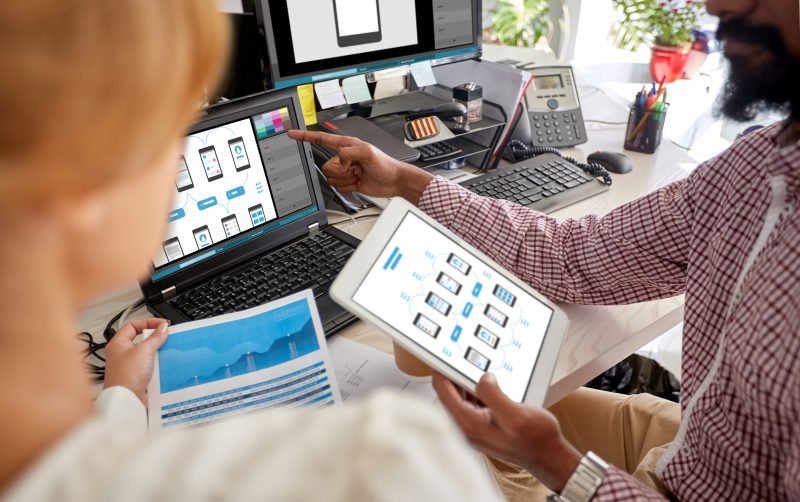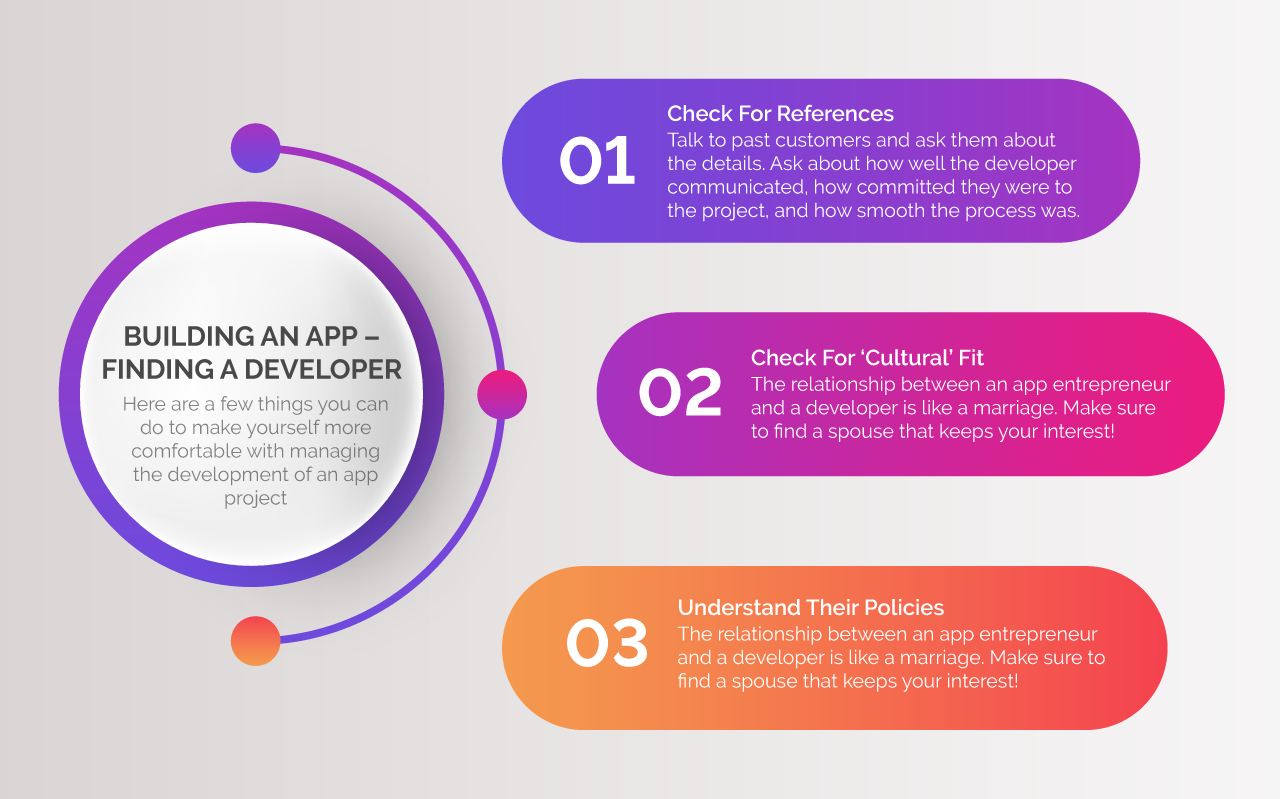Chances are, when you encounter a well-designed app, you can’t put your finger on exactly why it’s great. Great apps simply just feel good. And with so many apps on the market, if you’re going to compete, your users need more than smart color palettes and fancy gradients – users need to feel that your app has the “it” factor. If you’re going to win, you need to know how to design an app that captivates.
Unsurprisingly, most app entrepreneurs know what they want the app to do (heck, most of the time they’ve already named the app) but they have no idea how to actually design an app. And while we don’t expect that entrepreneurs should know how to single-handedly build a business model and develop the app, we do expect that most designers should know how.
But here’s what most people don’t realize: not all designers know how to build an app because building an app that stands out is hard. Sure, they may focus on selecting the right color tones and making sure that all the required elements are added (which is important!), but they may not be focused on how a user will feel the first time they use the app; problem solving isn’t their primary concern.
So, is it possible to deliver on the promise of a functional, user-friendly app that has a captivating aesthetic?
In our ultimate guide to building a mobile app, we’ll teach you exactly how to design an app that is cutting-edge but familiar; beautiful but easy to adopt; and ultimately, one that stands out amongst the hundreds of thousands of apps in the app store.
Getting Started
1. Understand the Problem You’re Solving
Sure, a well-designed app looks good but aesthetic is not the only marker of a great app. In fact, most users believe that as long as the design allows them to accomplish their mission in some way then it must be a good design, right? Well, not exactly. To adopt an app into their daily lives, users are going to need a clear path, functional code, and design that engages. The whole enchilada.
And that begins with not only understanding the problem you’re solving but partnering with the right team to translate how your solution clearly solves that problem.
2. Create a Wireframe For Your App
A wireframe is the blueprint for your design; or rather, a draft of your app’s visual architecture. It’s meant to serve as a functional sketch so don’t worry about including color palettes, logos, or interactive design at this stage in the game. Getting your workflows on paper will help your idea come to life, as well as help bridge any technical language gap between you and the developer or agency you hire. How many times have you tried to explain your vision only to have it come out all wrong? A wireframe helps translate your idea when words seem to fail you.
And because building a mobile app is different than building a mobile-first website, creating a wireframe will help you communicate your app’s value proposition.
Wireframes can be sketched with pencil and paper or, for a more finished look that you can share digitally, here are some of our favorite free and paid resources for wireframing:
- Wireframe.cc
- InVision
- Balsamiq
- Axure
- Marvel (great for prototyping)
Designing and Developing Your App
3. Find a Savvy Designer
Remember those smart color palettes and beautiful interfaces we talked about? Now it’s time to think about the design of your app and hire a designer to bring those elements to life.
This is an important step because, much like the functionality of the app, a great design will leave a lasting impression on your users. We strongly recommend hiring a designer because, even if you’re a gifted designer yourself, bringing an experienced designer on board to translate your wireframes into beautiful mockups frees up your energy for successfully launching and monetizing your app. Build a stronger app by hiring for your weaknesses.
Here, we’ll break down your options for hiring a designer as well as app design tips to keep in mind as your app comes to life.
Working directly with a designer
Pros: If you have a clear vision of how you want your app to look, working 1-1 with a designer can be a great option.
Cons: You’ll have to do the legwork to find a designer with mobile app design experience, as well as independently source a developer who can translate that design into functional code.
Using an app builder
Pros: This option is best suited for those with low budgets and very basic expectations.
Cons: Much like a website builder, you can build a basic app with this option but if you have any complex ideas or are scrapped for time, this isn’t the option for you.
Hiring an agency
Pros: Hiring an agency the complete package: you can lean back and let a qualified team build your app from the ground up. You’ll have a team of experts managing the design and development of your mobile app which leaves you to focus on other critical launch projects like marketing and monetization. And, you can still contribute input on design elements and the final product.
Cons: This will be the most expensive option but if you want it done right the first time and without having to micromanage or sacrifice your own time, it’s a tough option to beat.
App Design Tips
4. Pick Colors and Fonts That Serve A Purpose
Colors not only brighten the world around us, they’re also a powerful communication tool that can evoke emotions, thoughts, and behaviors. Use the effects of color psychology to your advantage and select hues that evoke strong (positive) responses.
Similarly, the fonts you choose will influence the look and feel of your mobile app. Sans serif fonts (type faces without little feet) offer a more contemporary, modern look while serif fonts (fonts who have feet) bring a more traditional or professional look to your design.
Make sure to consider the hidden meanings these design elements communicate and choose them mindfully.
5. Put the User’s Needs First
For your app to be a smash hit, you need users to understand its purpose, have an easy time navigating through it, and make it something they will adopt into their daily lives. And then, of course, you need people to tell their friends about your app.
So, where do you start? Here, we share the three most influential characteristics of a great mobile app:
- Easy navigation;
- Clean, simple design;
- Beautiful interfaces
6. Simplicity is Key (Especially On a Small Screen)
A clean, simple design helps make the user experience as enjoyable and easy as possible.
Designing for simplicity means generous use of white space and using familiar symbols and phrases.
By using white space, the unmarked area around design elements, to bring balance to your design, you give the user a chance to process what they’re seeing without feeling overstimulated. Too much information presented on screen and your user is likely to become overwhelmed and abandon the app.
And by keeping symbols and language familiar, the user feels like they know their way around; they’ve been here before.
7. Offer Easy Navigation and Familiar Layout
Provide users with a layout and symbols that are familiar to them, so they’ll know intuitively how to navigate through your app.
It’s no secret that humans need direction. People are more likely to stick with it when they have clear guidance on where they’re supposed go next. But a user can’t navigate the app if the nav bar and options are hidden, so ensure the user always knows where to go.
How do you make that happen? Give the user a smooth navigation and buttons and links that are finger-friendly (we’re not designing apps for PalmPilots here, people).
Inversely, there’s nothing worse than taking an action and the action resulting in… nothing. nada. zilch. Never leave your user wondering what went wrong or what to do next. Be sure to include clear feedback when a user “takes a wrong turn” or enters invalid information.
Remember, you’re designing a mobile app, not a mobile site so respect the user’s journey through your app with these tips:
- Avoid mandatory sign in
- Avoid asking permissions too early on
- Allow them to try the app before requiring that they sign in
- Make it easy for the user to register or sign-in by offering social media login capability to save time and cut down on the number of passwords they have to remember
- Create forms that allow simple data input
- Make information bite-sized and easy to process
- Minimize the scrolling required for main screens (the only exception to this rule is for lists).
8. Find the Right Developer to Build Your App
You’ve got an idea for an app but you have no idea how to build it. And let’s be frank: finding a great developer to bring your app idea to life can be a real challenge. In most cases, but not always, there’s a correlation between the quality of the developer available to you and the size of your budget. If you can afford the best developers, you can hire the best developers.
But what if you don’t have deep pockets like Duck McScrooge? Not to worry, you can still find the right developer for your project. Here, we outline what to consider when finding a developer, regardless of budget:
- Ask for a comprehensive portfolio of apps they’ve built in the past.
- What’s their experience in designing apps for both iPhone and Android?
- Download those apps and test them on your own. Are they easy to use? Does the code function properly? Is this an app you would integrate into your daily life?
- Check their references
- Ask the developer’s past clients about how well they communicated, how committed the developer was to the project, and how smooth the development process was. Check the developer’s reviews on sites like BBB and Clutch.co for additional feedback.
- How much does it cost to design an app?
- This is a big one. Iconic brands can, and do, spend millions of dollars developing their mobile apps, so if you expect to compete with these apps with a $2,500 budget, think again. High-quality, low-cost app development does not exist. If a developer is promising you the moon and the stars for pennies on the dollar, that developer has either never built an app before or won’t finish the project (and just may ride off into the sunset with your deposit).
- To give you a baseline, quality app development agencies often charge anywhere from $45 to $100+ per hour. In many cases, a full-scale mobile application will easily cost over $50,000 to develop all of the features and functions.
- Discuss development fees up front to get a realistic idea of what it will cost to bring your idea to life.
- What are their policies and procedures?
- As with any partnership, communicating expectations and understanding each other’s policies and boundaries is vital for a healthy, working relationship. In other words, if you don’t even enjoy dating the person, don’t marry them.
Testing Your App
Congratulations! Now that your developer has translated your vision into functional code, you now have a minimum viable product; enough features to satisfy your early users to test the app for feedback and ongoing development. Every feature and function should operate properly so you can gather user feedback before the app launches. When it comes to mobile apps, your MVP will be a real application, but only includes core features. This phase allows you and your developers to launch your app quicker (and with a smaller budget), while attracting early adopters in order to generate insights and feedback. Instead of spending thousands of dollars to build a full-featured app that may or may not succeed in the market, testing your MVP only is a great way to gauge interest and usage behavior before developing further features.
Launching Your App
Launching your mobile app begins months before your app goes live in the app store. And because a successful launch is just as critical as the functionality of the app itself, we’ve created a separate guide for how to ensure a successful app launch.
Post Launch
Design practices change often, so even after your app is launched, continue to test usability and research updates that will make your app more efficient and user-friendly while avoiding fluffy trends.
With the average person spending approximately four hours a day on their phones, and more than 180 billion mobile app downloads per year, there’s plenty of opportunity to capture the attention of an engaged market. But the competition is stout, so if you’re going to create an app, follow the guide we’ve outlined for you, translate user insights into improvements, and begin mapping your launch strategy well in advance.











